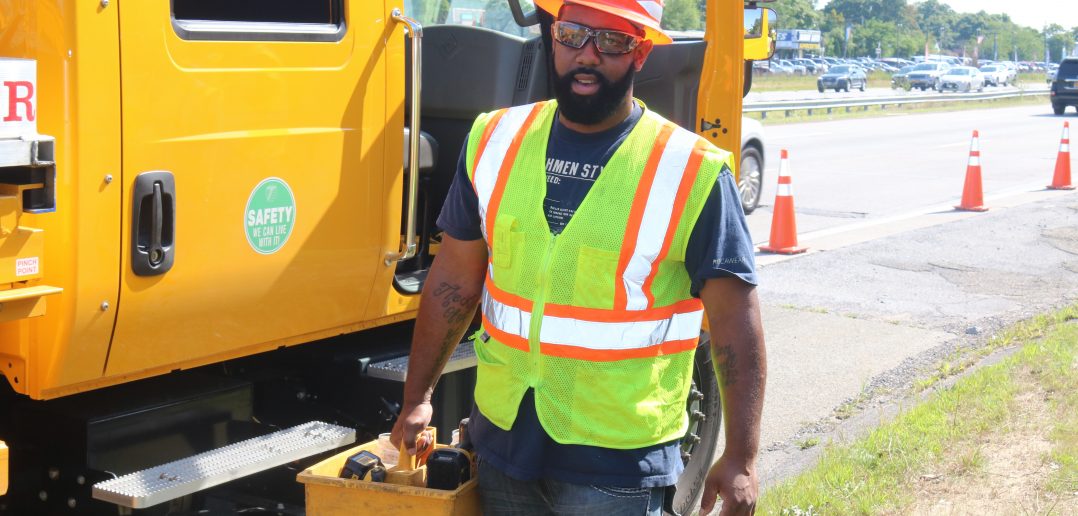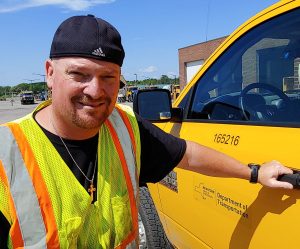‘Every day you’re out there, you feel vulnerable’
Thousands of CSEA members employed by the state Department of Transportation (DOT) and local government agencies are working hard to maintain and improve roadways across the state.
Working on or near roadways is among the most dangerous work that our members do. CSEA members and other workers who perform duties on or near highways face close calls and challenges every day, whether it’s from distracted drivers, reckless motorists or members of the public expressing frustration at roadwork.
The numbers are daunting. Across the United States, there is a work zone fatality every 11 hours and a work zone injury every 13 minutes.
More than 50 of our members have lost their lives working on roadways since CSEA began keeping such records in 1983.
Our union is fighting to make work zones safer, not only for our members who are in work zones every day, but for the general public.
“These are our brothers and sisters, and someone’s parent or child, who are working in these work zones every day,” CSEA President Danny Donohue said. “Nothing is more important to our union than worker safety. We all need to get involved and do our part to ensure that our employers are protecting our members who are in work zones, and work to minimize the risks our members face.”
Through our ongoing Don’t Zone Out campaign and other efforts, our union has successfully fought to strengthen our state’s ‘Move Over’ law; raised public awareness on work zone safety through many venues, including public education sessions, information days, awareness events and collateral; worked with state and local government officials on policies and practices to improve work zone safety and educating our members on work zone safety.
Below are some stories from CSEA members who work on roadways. To learn more about what you can do to help make work zones safer, visit cseany.org/work-zone-awareness.
Guglielmino: ‘People aren’t getting how dangerous this is’
Joseph Guglielmino, a highway maintenance supervisor 1 at the state Department of Transportation, and his crew work primarily on Interstate 84 and the Taconic State Parkway, busy roads that have become even busier as more people have moved north.
“We deal with the volume of traffic, and people not adhering to signs, not moving over and not slowing down,” said Guglielmino, a 31-year DOT employee who also serves as 1st Vice President of our Department of Transportation Region 8 Local. “People will move over after they see the first truck, then get back into their lane instead of staying over until they’re out of the work zone.”
Guglielmino said that distracted drivers is a major problem facing the workers.
“You could be in the truck at any point in the day and see people on their phones and their tablets. I’ve even seen people reading a book,” Guglielmino said. “Cell phone use and texting are the biggest things we see.”
“People just aren’t getting how dangerous this is for us.”
— Jessica Ladlee
Drake: Increased signs will tackle driver frustration
State Department of Transportation Region 8 Local President William Drake Sr., whose local encompasses five counties, said proactive measures must be taken to quell what he feels is a growing trend of road rage and frustrated drivers.
Drake said he’d like to see increased use of mobile digital sign boards to give drivers ample notice of planned roadwork, so motorists can choose alternate routes ahead of time. Drake said that increased signage would also give drivers more time to move into a lane away from the work zone.
“People want their roads fixed, but they don’t want to wait,” Drake said. If we had signs that say we have roadwork coming, [drivers]will know ahead of time. If [drivers]are sitting in traffic, they sometimes yell and scream.”
Drake would also like to see an increased police presence in the work zones.
While State Police are stationed in locations near the entrance of work zones, Drake believes this has a mixed effect. “When the drivers get past the police, they speed back up as they’re entering the work zone,” he said. “[Drivers are] speeding through our work zone.”
— Jessica Ladlee
As state steps up enforcement, members urge awareness
New York State Police and the Department of Transportation (DOT) recently announced the start of “Operation Hardhat,” a joint effort to crack down on work zone violations and highlight the importance of safe driving through active construction and maintenance work zones on state and local highways.
State Police are patrolling work zones, including in Western New York, to ticket motorists who disobey flagging personnel, speed through a work zone or violate the state’s Move Over Law.
“Law enforcement and other emergency responders, including CSEA and PEF highway workers, work in a dangerous environment and risk their lives to keep the traveling public safe,” New York State Police noted in a recent news release. “It is important that motorists are aware of their responsibility to follow the rules of the road and know that violations of the Move Over Law and work zone intrusions will not be tolerated.”
Andy Hahn, a DOT highway maintenance supervisor and CSEA DOT Region 4 (Rochester) Local activist who has logged 20 years on the job, said raising awareness about improving the safety at highway work zones is timely and necessary.
Hahn called the day-to-day highway work ‘tense.’ “You must maintain a hyper-awareness about what is going on around you,” he said.
CSEA DOT Region 4 (Rochester) Local President Chuck Parsons, who has worked at the agency for more than 36 years, said our members are being proactive when it comes to workplace safety, including getting training in improving work zone safety and participating in ‘train-the-trainer’ sessions.
“It is critical that motorists pay attention behind the wheel and eliminate distractions, especially on interstates and other multi-lane highways,” Parsons said. “Educating the public is key to making sure our members go home unscathed tonight. Keeping everyone safe in a work zone is truly everyone’s business.”
— Ove Overmyer
Cornell Scott: ‘Sometimes, traffic is as close as a foot away’
Cornell Scott, a highway maintenance worker 1 at the state Department of Transportation’s Riverhead residency in Suffolk County, urges motorists to be aware while driving in work zones.
“You never feel completely comfortable when you’re out there,” Scott said. “You have to be really careful because many people aren’t paying attention [on the roads].”
Scott is well aware of what highway workers risk. “Someone from out here was killed years ago, so I always keep that in the back of my mind,” he said. “You always have to keep your eyes and ears open, you always have to be aware and you always have to be on point because things can change in an instant.”
Scott noted that the state’s ‘Move Over Law’ has helped keep work zones safer for workers.
“The Move Over Law is really important because it prevents accidents,” he said. “If I’m parked on the right shoulder [of the road], and I get in and out of the truck, I have plenty of room if [the law is obeyed].”
After inclement weather, trucks are often at risk for becoming stuck, so Scott said workers must park closer to traffic in these cases, limiting the space they have to get in and out of the vehicles.
“Sometimes, traffic is as close as a foot away and [drivers]are flying by; they’re not slowing down. So, the Move Over Law is a very big deal for us [DOT workers]. We all have families and we all want to go home at night, so we need drivers to slow down when they see us.”
— Wendi Bowie
Allen: ‘All it takes is one mistake’
CSEA Department of Transportation Region 10 (Babylon) Local President Richard Allen, a highway maintenance supervisor 1, primarily works on the busy Sunrise Highway in Nassau County, where he noted that there are always vehicles less that 2 feet away from crews in work zones and manholes are often in the middle of the road, including intersections.
“Your head has to always be on a swivel because all it takes is one person not paying attention and it’s a bad day,” Allen said.
Allen noted that workers try to protect themselves by surrounding themselves with trucks.
“If someone is driving recklessly, it’s better to have a truck damaged than for someone to lose their life,” he said. “We have cones out to guide traffic, but people ignore them, so we try to surround ourselves with the trucks for extra protection.”
Even with strong precautions, Allen said he still feels he’s at risk.
“Every day you’re out there, you feel vulnerable,” he said. “All it takes is for a driver to make one mistake and you can be seriously hurt or injured.”
“Please pay attention and stay off of your phone,” Allen said. Remember, we’re somebody’s [family member]. We want to go home at the end of the day, too.”
— Wendi Bowie









